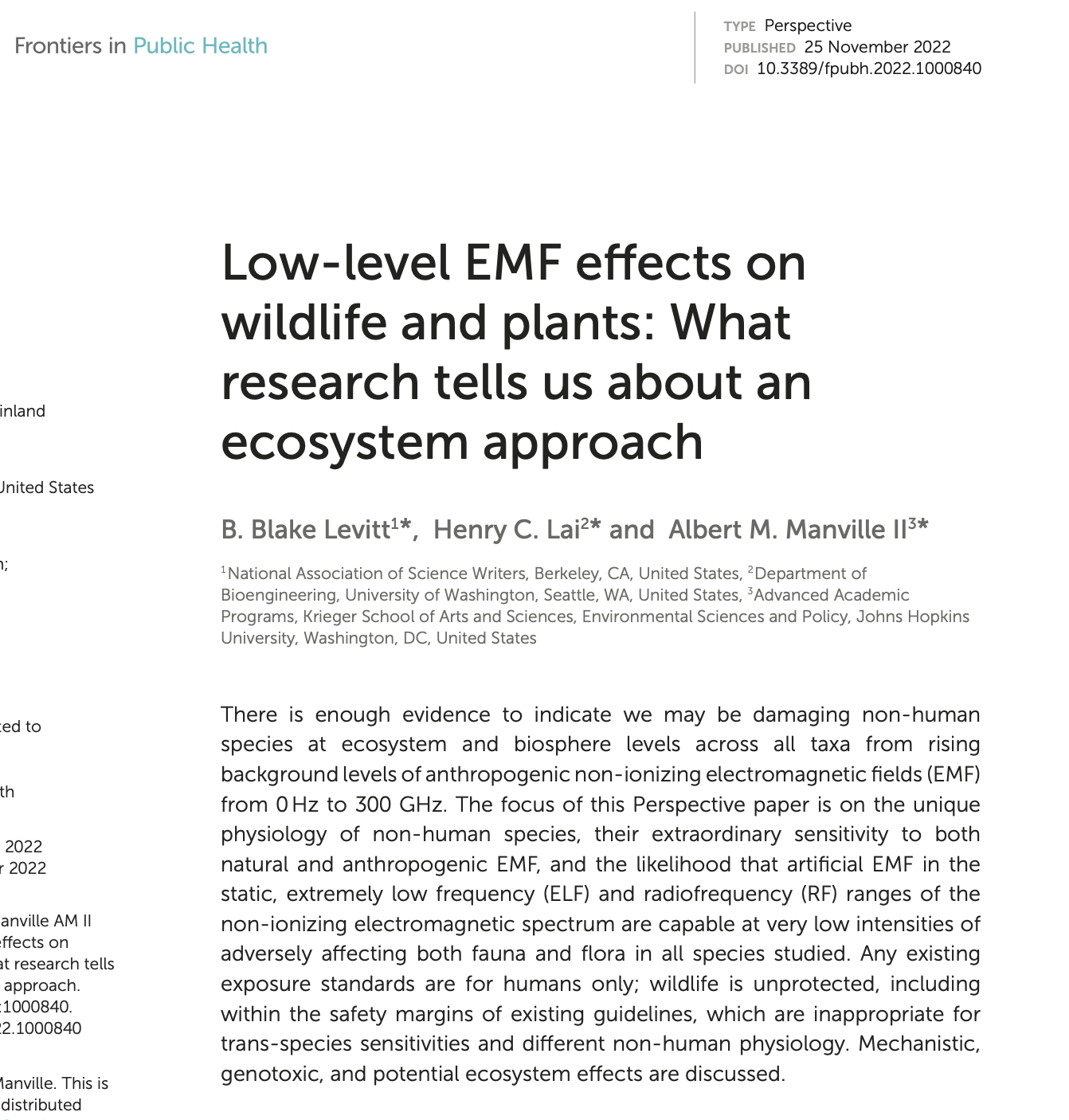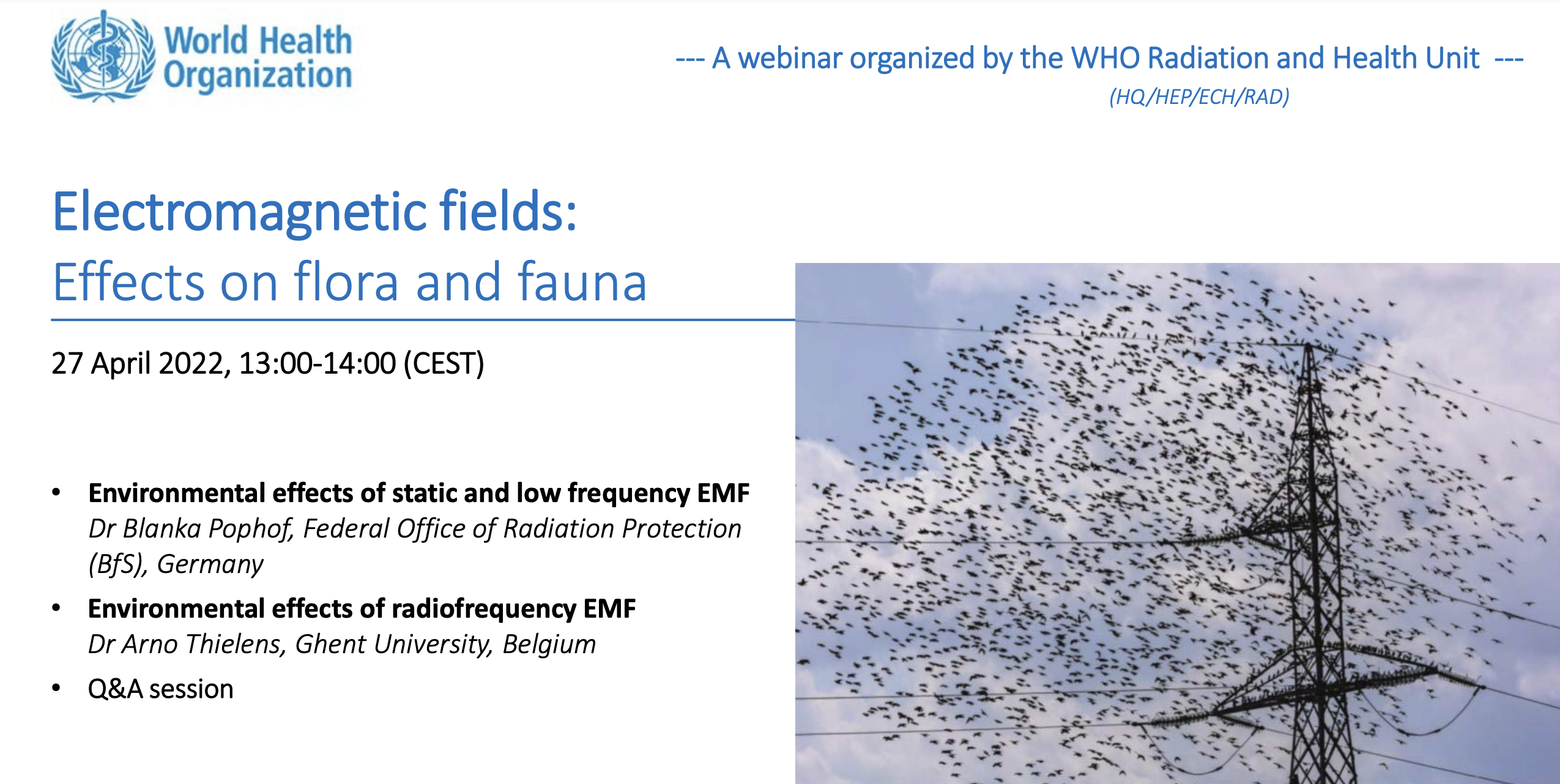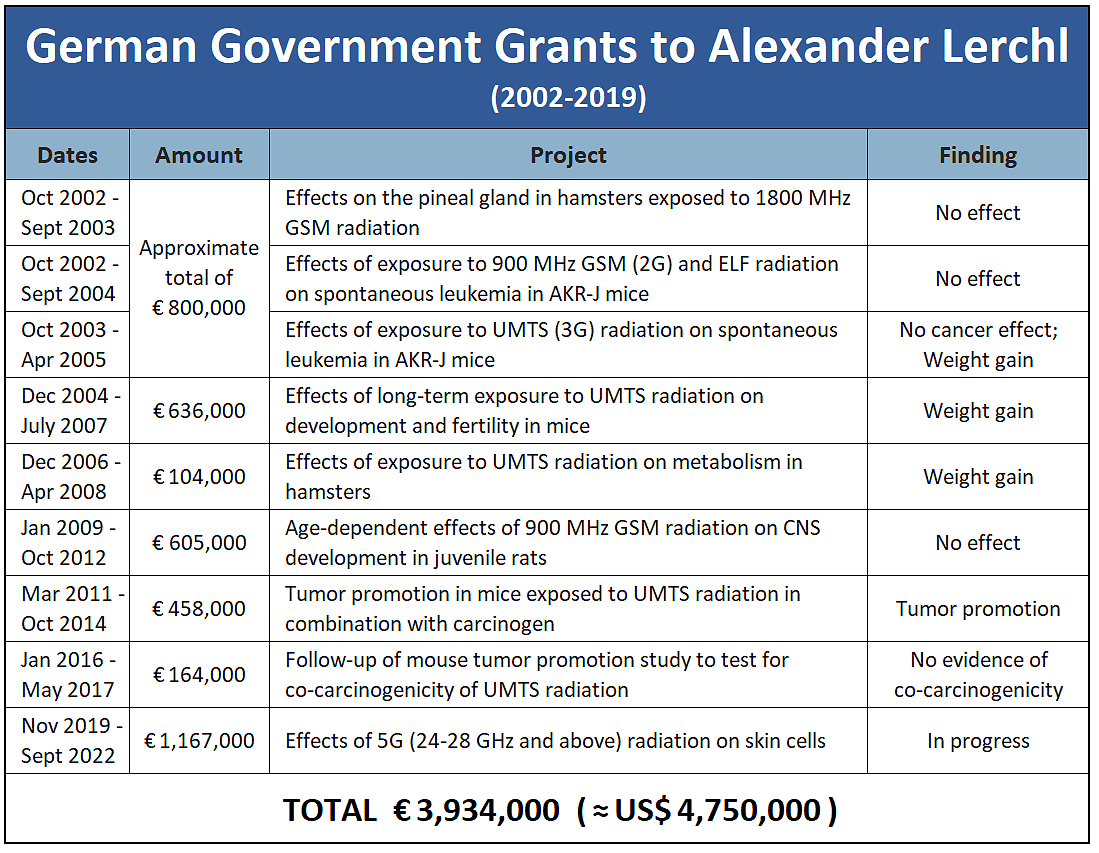2021 Short Takes
Runs over 200 Pages and Includes More Than 1,000 References
WHO Webinar on ELF EMF and RF Effects on F&F
A detailed examination —likely the most exhaustive ever attempted— of the environmental effects of non-ionizing radiation has been published in Reviews on Environmental Health.
“Effects of Non-Ionizing Electromagnetic Fields on Flora and Fauna” is in three parts, the last of which was posted today. They are:
- Part 1. Rising Ambient EMF Levels in the Environment
- Part 2. Impacts: How Species Interact with Natural and Man-Made EMF
- Part 3. Exposure Standards, Public Policy, Laws, and Future Directions
Taken together, the three papers run over 200 pages in the journal and include more than 1,000 references.
The authors are Blake Levitt, Henry Lai and Albert Manville. Levitt is a science journalist, based in Connecticut, and the author of Electromagnetic Fields: A Consumer's Guide to the Issues and How To Protect Ourselves, first published in 1995. Lai is a professor emeritus at the University of Washington, Seattle. In the 1990s, he and N.P. Singh were the first to show that ELF (60 Hz) EMFs and RF radiation could lead to DNA breaks. Manville is a lecturer at Johns Hopkins University in Baltimore and, formerly, a wildlife biologist with the U.S. Fish and Wildlife Service.
“We approached it from the biology/environmental ecosystem level, rather than the typical physics and/or human physiology side,” Levitt told Microwave News.
She added that they are planning to publish a book on the topic for the lay reader.
WHO Webinar: EMF Effects on Flora & Fauna
April 21, 2022
The World Health Organization (WHO) will host a webinar on April 27 on Electromagnetic Field Effects on Flora and Fauna. There is no charge for listening in, but you must register by April 26. The one-hour session will be recorded and made available to those who register.
The speakers will be Blanka Pophof of the German Federal of Radiation Protection (BfS) and Arno Thielens of Ghent University in Belgium.
May 2, 2022
A video recording of the one-hour webinar has now been posted. Go to:
http://bit.ly/39yaFzt
and use passcode:
6Fn#pDVS.
A transcript is also available.
Fourth Paper by Levitt, Lai and Manville
November 25, 2022
Today, Levitt, Lai and Manville published a new paper (their fourth) of EMF/RF effects on wildlife and plants in Frontiers of Public Health.
They write: “Long-term chronic low-level EMF exposure guidelines, which do not now exist, should be set for wildlife... We have a long overdue obligation to consider potential consequences to other species... The evidence requiring action is clear.”
This new paper is open access. Here’s the abstract:

Alexander Lerchl Has Received $5 Million in Research Grants from German Government
Alexander Lerchl’s bogus campaign against the REFLEX project and members of Hugo Rüdiger’s lab did nothing to harm his career. Just the opposite, Lerchl thrived as he gained stature and a succession of rich research grants from the German government.
Over the last 20 years, Germany’s Federal Office of Radiation Protection —the Bundesamt für Strahlenschutz, or BfS for short— has given Lerchl $5 million in contracts. Lerchl has been the best-funded RF lab researcher in Germany, Europe, and, most likely, the world (see Table below).
“Invalidating the REFLEX study and showing that mobile phone radiation is harmless are in the interest of his patrons —the BfS and the mobile communication industry,” Franz Adlkofer told Microwave News. “Both have embraced him.” Adlkofer ran the REFLEX project and supported Elisabeth Kratochvil’s lawsuit against Lerchl that led to his censure in a December court decision (see accompanying story).
The BfS is also the principal sponsor and institutional home of the International Commission on Non-Ionizing Radiation Protection (ICNIRP). In each of the last three years, it has contributed 70-80% of ICNIRP’s annual income. Like Lerchl, ICNIRP has refused to recognize, and has often dismissed, the cancer risks associated with mobile phones.
In 2008, as he was waging his campaign against the Rüdiger lab, Lerchl was appointed to a two-year term as chairman of the Non-Ionizing Radiation Committee of the German Radiation Protection Commission, known as the SSK, and was reappointed in 2011. For four years, 2009-2012, Lerchl was, effectively, the most senior advisor on EMFs and RF radiation to the German government. (The SSK advises the BfS.)
As early as May 2013, the directors of Diagnose:Funk, a German-Swiss environmental and consumer protection group, issued a public statement calling for Lerchl to be disavowed by the BfS management and other scientific, governmental and academic officials. They asked:
“For how long is this man still to be tolerated by the scientific community as a research project leader, by the Jacobs University Bremen as a tenured professor, and by politicians as an advisor?”
In an interview with Diagnose:Funk, posted online on February 4, Adlkofer echoed those same eight-year-old sentiments. Politicians “must ask themselves whether they can afford to continue working with a man who has been exposed as an unscrupulous slanderer,” Adlkofer stated.
Lerchl Silent on BfS’ Two Failed REFLEX Follow-Ups
In 2005, the BfS sponsored two projects to test the REFLEX findings. Both were beset with missteps and delays.
The first was a million-dollar (€832,000) contract to a young researcher, Petra Waldmann, at the College of Applied Sciences in Darmstadt. It appeared to be an obvious attempt to engineer a negative finding. Waldmann was tasked with using a cell type that Rüdiger and Kratochvil had already shown to be unresponsive to mobile phone radiation. At the time, Adlkofer had warned the BfS that “you won’t see an effect” with those cells. She didn’t. Inexplicably, Waldmann took seven years to publish her negative results in Radiation Research.
To save face the BfS soon commissioned a second project, also in Darmstadt, at a cost of $700,000 (€566,000) which called for exposing the same type of cells (lymphocytes) in which Rüdiger had seen DNA breaks. No effects were found. These results are not easily accessible. They were never published in a peer-reviewed journal and the final report was not released for six years —not until 2014, eight years after the first Rüdiger paper. The report runs 268 pages and is available in German only, with a one-page abstract in English.
Amid his never-ending criticism of REFLEX, Lerchl came to see himself in the role of policing the EMF/RF literature to weed out what he saw as bad science and misconduct. Yet, he never once called out either group of Darmstadt researchers, or his benefactors at the BfS when they decided to use an inactive cell type, or when the Darmstadt group failed to publish its findings.
Importantly, Lerchl never acknowledged that a 15-minute walk from the Rüdiger lab, across the MUV campus, Wilhelm Mosgöller’s group was exposing the same cells to the same radiation and seeing changes in DNA repair. That is, Mosgöller was showing independent evidence of the claim at the heart of the Vienna controversy: RF radiation can affect DNA (more here).
Lerchl is a professor of biology at Jacobs University. He also has an appointment as a professor of ethics of science and technology.
Slow-Walking Cancer Studies
In 2011, while Lerchl was still chairman of the SSK NIR committee, the BfS awarded him over $500,000 (€458,000) for an animal experiment to repeat a German study which showed that 3G radiation can promote cancer. To just about everyone’s surprise, in 2015, Lerchl announced that he had confirmed the earlier finding.
A replication study has always been held as the sine qua non for regulatory action. Yet, BfS remained silent. It called for no reevaluation of the RF–cancer risk. Nor is there any indication that the BfS asked ICNIRP to investigate.
The BfS followed up with another contract, this time for $200,000 (€164,000), to allow Lerchl to see if he could better understand how RF promotes tumors. Though it ended in May 2017, Lerchl only published his findings late last year.
By then, the BfS had given Lerchl yet another contract, this time for close to $1.5 million (€1.2 million) for work on 5G radiation. News of this award was not without irony. Lerchl, who was known as an animal researcher, would now be following up Rüdiger’s cell culture studies. He would be doing the experiments that Adlkofer had lost due to the fallout of the Vienna Affair.
In a statement following the Bremen decision, Diagnose:Funk urged the BfS to cancel Lerchl’s 5G contract.
Others have called on Japanese and Korean officials to remove Lerchl from the advisory panel for the partial repeat of the U.S. NTP animal-cancer study.
See also: German Court Moves To Silence Relentless Critic of RF DNA Studies
and Lerchl’s Unattainable Prize: The IARC RF Panel
Cited Theory To Reject Low-Level EMF Effects
Robert K. Adair, the former chairman of the physics department at Yale University and a leading critic of any and all claims that weak EMFs can have biological effects, died on September 28. He was 96.
A particle physicist, Adair held one of Yale’s prestigious Sterling professorships. He was a member of the National Academy of Sciences. To the public, Adair is best known as the author of The Physics of Baseball.
During the 1990s, after retiring from teaching, he took a professional interest in the work of his wife, Eleanor Adair, who studied the physiological effects associated with microwave heating at the John B. Pierce Laboratory, also in New Haven (and later at Brooks Air Force Base in Texas). Over the next decade, Robert Adair published a series of scientific papers and commentaries, in which he maintained that, as he wrote in a 1992 letter to Science magazine, health risks associated with exposure to weak EMFs are an “imaginary problem.”
One of Adair's central arguments was that low-level fields could not affect biological systems because they are so much weaker than the natural thermal fluctuations in living systems (this is known as the “kT problem”). He once compared worrying about EMF health effects with being concerned that a cat will damage a tree by breathing on it during a howling wind storm.
In a letter to Physics Today in 1991, he wrote that “good scientists” consider very weak 60 Hz fields harmless “because their effects on the cellular level are very, very much smaller than thermal noise.” Earlier that same year, he presented his argument in a 10-page paper in the Physical Review under the title, “Constraints on Biological Effects of Weak Extremely-Low-Frequency Electromagnetic Fields.” He also published his views on EMFs in the Proceedings of the National Academy of Sciences. See, for instance, this 1994 paper on interactions with magnetite.
Adair had influential allies within the Yale physics community, notably Allan Bromley, who was also a Sterling professor and a chairman of its physics department. Bromley was the science advisor to President George H.W. Bush. In 1990, Bromley delayed the public release of an EPA report that classified power-frequency EMFs as a probable human carcinogen and microwave radiation as a possible carcinogen. Those cancer classifications were removed from the report prior to release and never officially acknowledged or acted on.
Frank Barnes, for one, has publicly disagreed with Adair. In an interview with Microwave News in 2016, Barnes said: “Bob Adair’s calculations are not wrong — they just don’t deal with the situations we are dealing with,” referring to the potential for RF radiation to promote cancer. Barnes is a distinguished professor emeritus of electrical engineering at the University of Colorado in Boulder and a long-time member of the National Academy of Engineering.
Eleanor Adair died in 2013 at the age of 86.
The Yale Department of Physics has posted an obituary for Robert Adair, under the title, “Explorer of Strange Particles —and Baseballs.” A shorter obit appeared in the New Haven Register.


